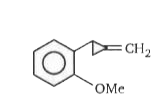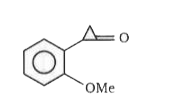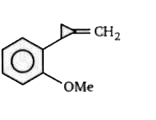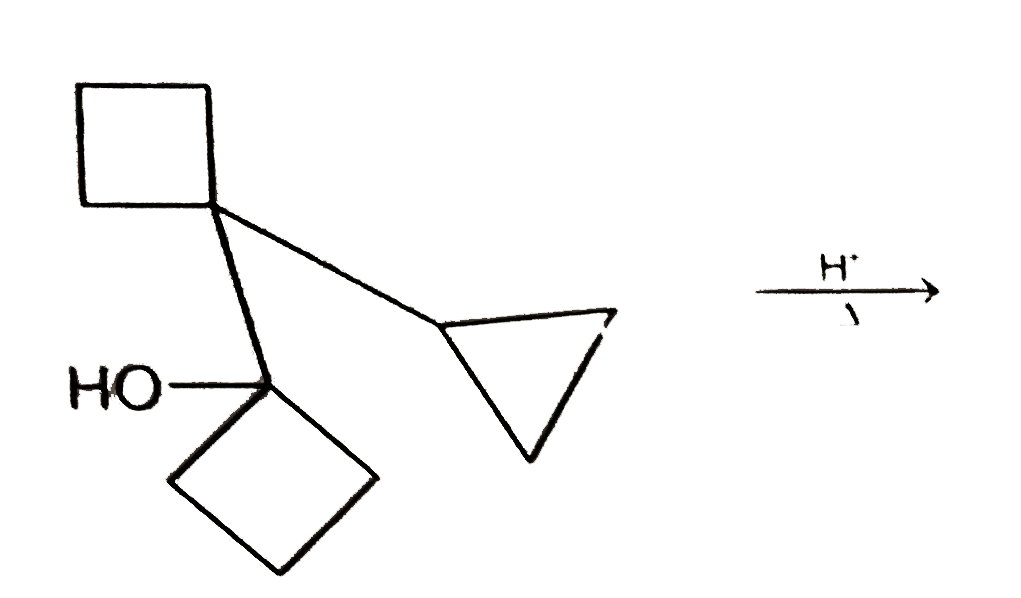Wolff rearrangement
R−C∣∣O−CHN2α−Diazoketone→R−CHKetene=C=O+N2
Topper's Solved these Questions
Similar Questions
Knowledge Check
- Question 1 - Select One
 , Product of rearrangement is :A
, Product of rearrangement is :A B
B C
C D
D
- Question 2 - Select One or More
Di-tert-glycols rearrange in the presence of acid to give alpa-tertiary ketones. The trivial name of the simplest glycol of this type is pinacol, and this type of reaction therefore is named pinacol rearrangement (in this specific case, the reaction is called a pinacol-pinacolone rearrangement). The rearrangement involves 4 steps. one of the hydroxyl groups is protonated in the first step. A molecule of water is eliminated in the second step and a tertiary carbocation is formed. The carbocation rearranges in the third step into a more stable carboxonium ion via a [1,2] rearrangement. In the last step, the carboxonium ion is deprotonated and the product ketone is obtained.

What is R.D.S. of pinacol-pinacolone rearrangement?AI stepBII stepCIII stepDIV step - Question 3 - Select One
Di-tert-glycols rearrange in the presence of acid to give alpa-tertiary ketones. The trivial name of the simplest glycol of this type is pinacol, and this type of reaction therefore is named pinacol rearrangement (in this specific case, the reaction is called a pinacol-pinacolone rearrangement). The rearrangement involves 4 steps. one of the hydroxyl groups is protonated in the first step. A molecule of water is eliminated in the second step and a tertiary carbocation is formed. The carbocation rearranges in the third step into a more stable carboxonium ion via a [1,2] rearrangement. In the last step, the carboxonium ion is deprotonated and the product ketone is obtained.


How many products obtained in above reaction?A1B2C3D4
Cope rearrangement
View Solution
The rearranged alkene, product after rearrangement at low temperature will be mainly:View SolutionWhich of the following is not a rearrangement reaction ?
View SolutionDi-tert-glycols rearrange in the presence of acid to give alpa-tertiary ketones. The trivial name of the simplest glycol of this type is pinacol, and this type of reaction therefore is named pinacol rearrangement (in this specific case, the reaction is called a pinacol-pinacolone rearrangement). The rearrangement involves 4 steps. one of the hydroxyl groups is protonated in the first step. A molecule of water is eliminated in the second step and a tertiary carbocation is formed. The carbocation rearranges in the third step into a more stable carboxonium ion via a [1,2] rearrangement. In the last step, the carboxonium ion is deprotonated and the product ketone is obtained.

 View Solution
View SolutionDi-tert-glycols rearrange in the presence of acid to give alpa-tertiary ketones. The trivial name of the simplest glycol of this type is pinacol, and this type of reaction therefore is named pinacol rearrangement (in this specific case, the reaction is called a pinacol-pinacolone rearrangement). The rearrangement involves 4 steps. one of the hydroxyl groups is protonated in the first step. A molecule of water is eliminated in the second step and a tertiary carbocation is formed. The carbocation rearranges in the third step into a more stable carboxonium ion via a [1,2] rearrangement. In the last step, the carboxonium ion is deprotonated and the product ketone is obtained.

 View Solution
View Solution

